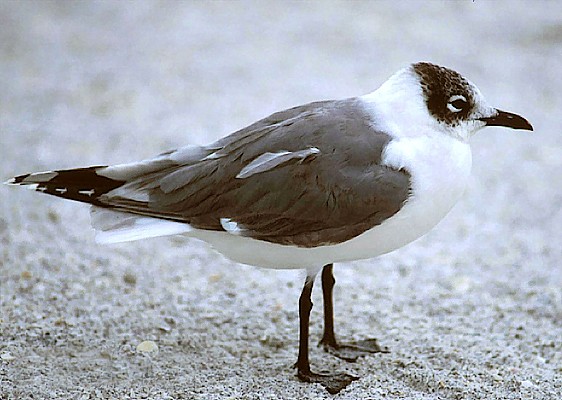Franklin's Gull
A species of Hooded Gulls Scientific name : Leucophaeus pipixcan Genus : Hooded Gulls
Franklin's Gull, A species of Hooded Gulls
Botanical name: Leucophaeus pipixcan
Genus: Hooded Gulls
Content
Description People often ask General Info
Description
It breeds in central provinces of Canada and adjacent states of the northern United States. It is a migratory bird, wintering in Argentina, the Caribbean, Chile, and Peru. The summer adult's body is white and its back and wings are much darker grey than all other gulls of similar size except the larger laughing gull. The wings have black tips with an adjacent white band. The bill and legs are red. The black hood of the breeding adult is mostly lost in winter. Young birds are similar to the adult but have less developed hoods and lack the white wing band. They take three years to reach maturity. Measurements: Length: 12.6-14.2 in (32-36 cm) Weight: 8.1-10.6 oz (230-300 g) Wingspan: 33.5-37.4 in (85-95 cm) Although the bird is uncommon on the coasts of North America, it occurs as a rare vagrant to northwest Europe, south and west Africa, Australia and Japan, with a single record from Eilat, Israel, in 2011 (Smith 2011), and a single record from Larnaca, Cyprus, July 2006. At the beginning of 2017 has been observed also in Southern Romania, southeast Europe. 
Size
33-38 cm (13-15 in)
Colors
Black
Gray
White
Life Expectancy
9 years
Nest Placement
Floating
Clutch Size
2 - 4 eggs
Incubation Period
1 brood
Number of Broods
23 - 26 days
Feeding Habits
Franklin's Gull primarily feed on invertebrates, especially insects, during breeding. They actively forage over wetlands and farmlands, often following tractors. Their diet includes beetles, grasshoppers, locusts, and earthworms, also consuming small fish and crustaceans by shorelines in winter, and occasionally scavenging at dumps.
Habitat
Franklin's Gull's primary breeding habitat includes freshwater marshes teeming with emergent vegetation. Post-nesting, their range extends to prairies and assorted wetlands, often near agricultural lands for foraging. Remarkable adaptability is exhibited during migration across varied North American terrains and at altitudes up to 14,000 feet. Wintertime finds franklin's Gull in coastal zones and oceanic areas within 30 miles of land, with some groups inhabiting high-altitude Peruvian lakes.
Nest Behavior
Franklin's Gull engages in cooperative nest building. Both sexes contribute to the construction process that continues throughout incubation, due to the decay and sinking of the nest's material. Nest building coincides with the breeding season, with parents diligently adding vegetation to maintain the nest.
Nest Characteristics
Franklin's Gull constructs nests in shallow water amidst floating or anchored vegetation, often near emergent plants. The nest is a platform of wet vegetation, likely pilfered from other nests, with a central depression. Initial construction is approximately 17 inches in diameter, expanding up to 40 inches. A notable feature is a small ramp on one side.
Dite type
Omnivorous
People often ask
General Info
Feeding Habits
Bird food type
Sounds
Call
Recording location: Chile
Behavior
Franklin's Gull displays a rich tapestry of social and breeding behaviors. Typical days are spent feeding, often in groups, and engaging in intricate courtship rituals that include vocal displays and mutual feather erecting accompanied by alternate movements to express interest. During nesting, both sexes share the construction of floating vegetation nests, incubation, and vigilant defense against predators, though they maintain a peaceful coexistence with neighboring birds. Post-hatching, franklin's Gull's parental involvement is steadfast, with both providing food and protection until fledging. Migration and wintering periods see franklin's Gull forming congenial, mixed-species flocks, showing their gregarious nature while remaining wary of disturbances, leading to silent 'panic flights' when threatened.
Scientific Classification
Phylum
Chordates Class
Birds Order
Shorebirds Family
Gulls Genus
Hooded Gulls Species
Franklin's Gull 